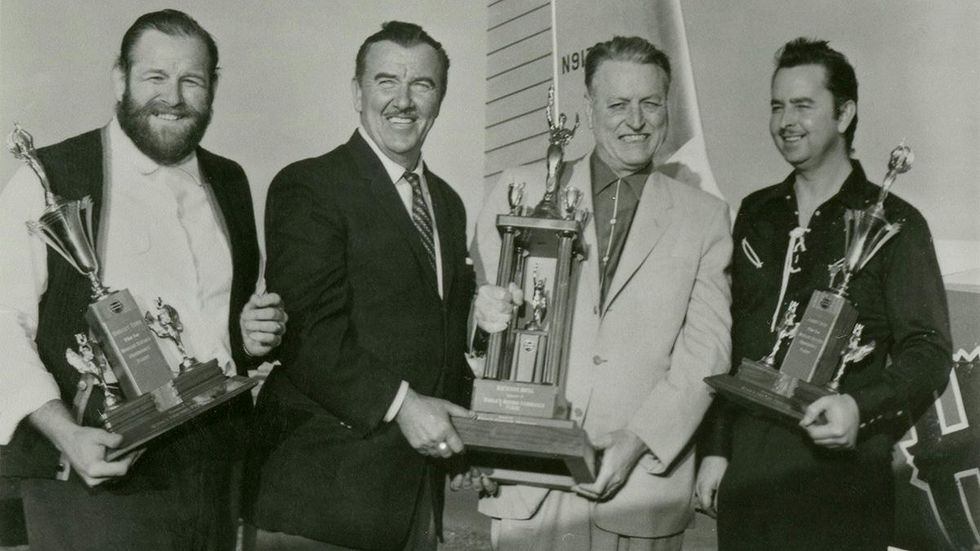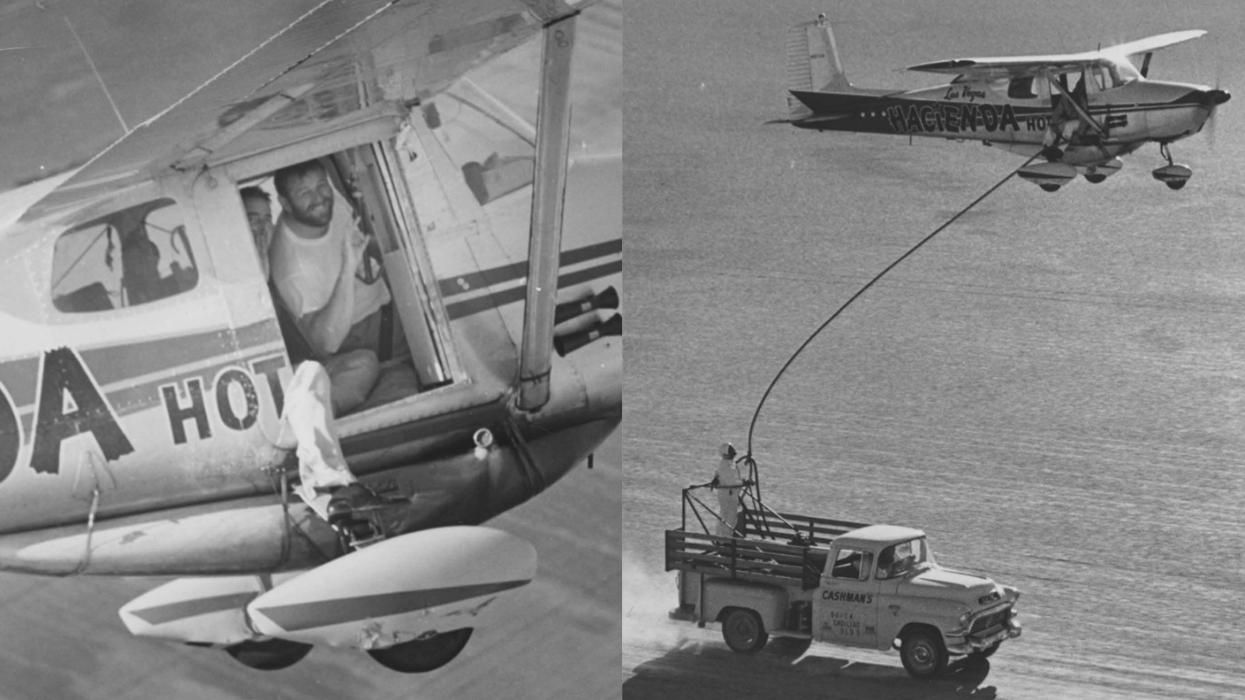All Rights reserved
By continuing to use our site, you agree to our Privacy Policy and Terms of Use.
By Jacopo Prisco, CNN
(CNN) – Late last August, a solar-powered drone called Zephyr almost beat one of aviation’s most enduring records.
The unmanned aircraft, operated by the US Army and produced by Airbus, flew for 64 days, 18 hours, and 26 minutes before unexpectedly crashing down in Arizona – just four hours shy of breaking the record for the longest-ever continuous flight.
Robert Timm and John Cook

PHOTO BY HOWARD W CANNON AVIATION
That record was set 64 years ago, in 1959, by Robert Timm and John Cook, who flew aboard a four-seater aircraft in the skies over Las Vegas for 64 days, 22 hours, and 19 minutes.
It’s remarkable that the Zephyr – a light aircraft with modern technology that was flying autonomously – not only failed to beat that time, but even if it had, Timm and Cook would still have retained the world endurance record for a crewed flight.
In fact, it’s nothing short of astonishing that Timm and Cook managed to stay in the air for so long, in an era that was closer to the Wright brothers’ first flight than today.
The fuel problem

PHOTO BY HOWARD W CANNON AVIATION
In 1956, the Hacienda hotel and casino opened at the southern end of the Las Vegas Strip.
It was one of the first family-oriented resorts in Las Vegas, and looking for publicity, the hotel owner took upon the suggestion of one of its employees: fly a plane bearing the hotel’s name on its side, and use it to beat the flight endurance record, which stood at almost 47 days in the air and had been set in 1949.
The employee, a former World War II fighter pilot turned slot machine repairman named Robert Timm, received $100,000 to set up the event, which was then tied to a fundraiser for cancer research.
Timm spent months modifying his chosen aircraft, a Cessna 172.
“It was a relatively new design,” says Janet Bednarek, an aviation historian and professor at the University of Dayton. “It’s a roomy four-seater airplane and it was known for being reliable and fairly easy to fly – something you don’t have to pay attention to every moment. And when you’re doing long duration, you want an airplane that's just going to kind of hum along there."
The modifications included a mattress to sleep on, a small steel sink for personal hygiene, the removal of most of the interior fittings to save weight, and a rudimentary autopilot.
“The important thing, however, was to create a way to refuel,” says Bednarek. “There had been a lot of experiments up to this point with aerial refueling, but there really was no way to modify a Cessna 172 to be refueled in midair. So they set up an extra tank that could be filled from a truck on the ground. When they needed to refuel, they would come down and fly very low and just above stall speed, then the truck came along and winched up a hose and then used a pump to transfer the fuel into the airplane. It really was a dramatic show of airmanship, because they had to do it at night sometimes and that required some precision flying.”
Fourth time’s a charm

PHOTO BY HOWARD W CANNON AVIATION
Timm’s first three attempts at the record ended abruptly due to mechanical failures, with the longest leaving him and his copilot in the air for about 17 days. In September 1958, however, the record itself was bested by another team, also flying a Cessna 172; it now stood at over 50 days.
For his fourth attempt, Timm selected John Cook, who was also an airplane mechanic, as his new copilot, having struggled to get along with his previous one.
They set off on December 4, 1958, from McCarran Airport in Las Vegas. As with the previous tries, the first step was to fly low over a speeding car, to get one of the landing wheels painted and rule out cheating: “There wouldn’t have been any way to track their altitude and airspeed at all times,” says Bednarek, “So they painted a white stripe on at least one of the tires. That would then be scuffed if they’d ever landed, and before their actual landing they would check to see that none of the paint had been scuffed off.”
The flight went smoothly at the beginning, and the pair spent Christmas Day in the air. Each time they refueled – over a stretch of very straight road along the California–Arizona border – they would also get supplies and food, in the form of dishes from the Hacienda’s restaurants that had been mashed up to fit into Thermos flasks, making it more practical to send them up to the plane.
Bathroom breaks happened on a foldable camp toilet and the resulting plastic bags were later thrown out over the desert. An extendable platform on the copilot side provided more space for shaving and bathing (a quart of bath water would be sent up every other day.)
The two would take turns sleeping, although the incessant engine noise and the aerodynamic vibrations made a restful night impossible. As a result of sleep deprivation, on day 36, Timm dozed off at the controls and the plane flew by itself for over an hour, at an altitude of just 4,000 feet. The autopilot had saved their lives – although it would stop working completely just a few days later.
The end, at last

PHOTO BY HOWARD W CANNON AVIATION
On day 39, the electrical pump that sent the fuel into the plane's tanks failed, forcing them to start completing the operation manually. When they finally beat the record, on January 23, 1959, the list of technical failures included, among other things, the cabin heater, fuel gauge, and landing lights.
“The important thing was that the engine kept going, which is really kind of remarkable. It’s a long time to be flying. Even if you keep it fueled and oiled, eventually just the heat and the friction are going to cause problems,” says Bednarek.
Nevertheless, the two remained in the air and kept going for as long as possible, to make sure their new record would be impossible to beat. They endured for another 15 days, before finally landing at McCarran on February 7, 1959, having flown nonstop for over two months and 150,000 miles.
“They had determined that they had passed the point where nobody else was going to try this – and nobody has,” Bednarek adds.
“I think they’d reached the end of the rope and decided it wouldn't have done them any good to crash, and so they came down. They were in pretty bad shape: We know that such a period of inactivity can be very bad for the body, and even though they did move around in the aircraft, they couldn't stand up or stretch and they certainly couldn't exercise or walk around,” Bednarek continues.
“It would be like sitting for 64 days – that is not good for the human body. They had to be carried out of the aircraft.”
Will this record ever be beaten by a human crew? Bednarek believes it could happen only if the attempt involved an aircraft testing some new form of propulsion or energy source, to show its utility.
Anyone aspiring to try, however, should heed the warning of copilot John Cook, who said this when a reporter asked if he would ever do it again: “Next time I feel in the mood to fly endurance, I’m going to lock myself in a garbage can with the vacuum cleaner running, and have Bob [Timm] serve me T-bone steaks chopped up in a Thermos bottle. That is, until my psychiatrist opens for business in the morning.”
The-CNN-Wire
™ & © 2023 Cable News Network, Inc., a Warner Bros. Discovery Company. All rights reserved.












































































